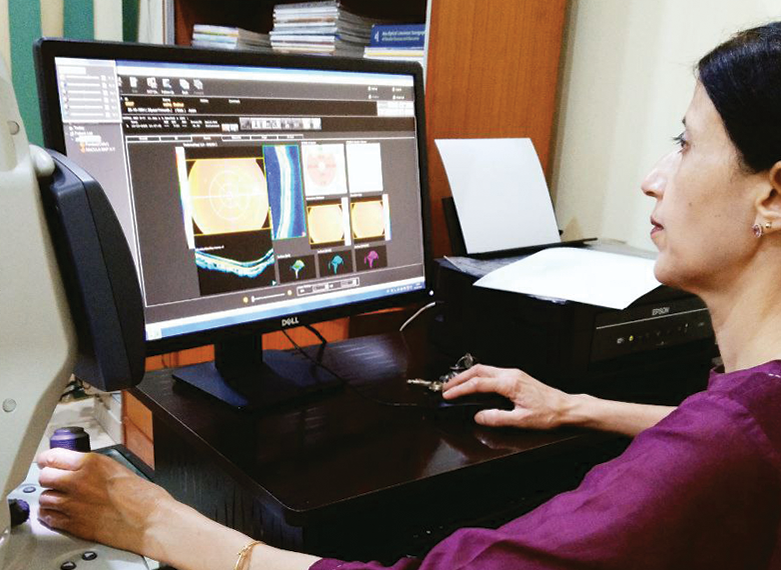
Glaucoma (Kala Motia)
Glaucoma is the most serious eyesight threatening condition. It usually manifests as a painless, gradual loss of vision. The lost vision can never be recovered. However, medical or surgical treatment can prevent or retard further loss of vision.
Risk factor for Glaucoma
People with family history of glaucoma.
Everyone over the age of 40 years.
Diabatic.
People with near sightedness (Myopia) for open angle type and far sightedness (hyperopia) for close angle type.
People with Hypertension.
People with Migraines.


Common symptoms of Glaucoma
Glaucoma is a silent thief of the eyesight. Patients are not aware of the gradual loss of eyesight until vision is significantly impaired
Pain around the eyes.
People with family history of glaucoma.
Colored halo rings seen around light bulbs.
Reduced vision in dim illumination.
Gradual decrease of side vision with the progression of glaucoma.
Frequent change of reading glasses, headaches, pain and redness of the eyes.
Tests for Glaucoma
Intra ocular pressure.
Water drinking test.
Gonioscopy.
Pachymetery
OCT (Optical coherence tomography)
Automated perimetery

Types of Glaucoma
Open angle Glaucoma
It is the most common form of glaucoma. It is caused by increased eye pressure which slowly causes damage to the optic nerve and consequent vision loss. Filtration angle is open. Parts of the drainage system don’t drain properly. Hence raised IOP of the eyes causes damage to the optic nerve. It usually responds well to medication, if caught early and treated.
Angle closure Glaucoma
It is a type of glaucoma in which the angle of the drainage area is closed or narrow. Aqueous humour inside the eyes cannot drain out normally which leads to the rise in eye pressure very quickly. Symptoms of angle closure glaucoma are headache, eye pain, nausea, rainbow around light and very blurred vision. Immediate oral medicines and eye drops to lower the high pressure of the eye and YAG peripheral iridotomy (YAG PI) is done to open the blockade.
Normal tension Glaucoma
Optic nerve is damaged even when IOP is normal. Risk factors such as low blood pressure contribute to normal tension glaucoma.
Congenital Glaucoma
Children are born with defect in angle that slows the normal drainage of fluid. Cloudy eyes, watering, sensitivity to light. Glaucoma filtration surgery is done at the earliest without much delay.
Secondary Glaucoma
Secondary Glaucoma develops as a result of other eye conditions such as eye injury, tumours, use of certain drugs like steroids. Pigmentary glaucoma occurs due to pigment release from the eye. Pseudoexfoliative glaucoma occurs due to deposition of flaky material.
Treatment of Glaucoma
Medicines
With the advent of various antiglaucoma drugs in the form of drops or pils, treatment of glaucoma is possible at early stage of the disease. Glaucoma medicines may be taken several times a day. They help control your eye pressure. These medicines are used regularly.
YAG peripheral iridotomy
It is performed in patients with narrow or closed angles. It prevents an acute rise in eye pressure.
Laser trabeculoplasty
It is performed by aiming yag laser onto the trabecular meshwork, hence stretching the drainage holes inside your eye.
Glaucoma filtering surgery
It involves creating an alternative filtration channel to drain the aqueous and control the pressure.
Trabeculectomy
In this surgery surgeon creates an alternative filtration opening under a scleral and conjunctival flap to drain out the aqueous and control the pressure.
Glaucoma drainage devices
These devices have shown success in controlling IOP in eyes with previously failed trabeculectomy, complicated glaucoma, neovascular glaucoma. These devices are in the form of implants, like Molteno, Baerveldt, and Ahmed glaucoma valve.
